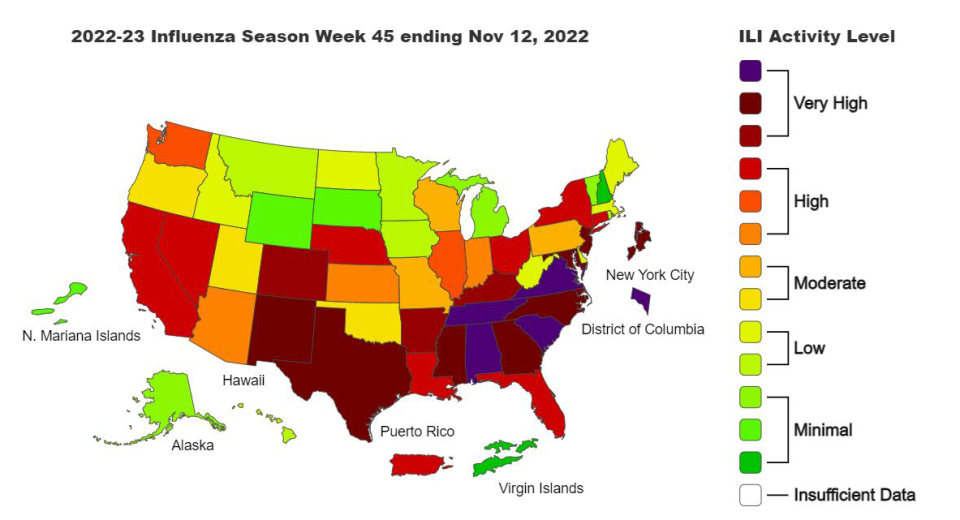How bad is flu? CDC reports most of the U.S. with high or very high flu levels
Influenza continues its fast and furious spread across the U.S., the Centers for Disease Control and Prevention reported Friday.
Most of the worst of respiratory illnesses remain concentrated in Southern states like Alabama, South Carolina, Tennessee and Virginia. There are signs that flu is ramping up in other areas such as Colorado, New Mexico and Texas, according to the CDC.
Such widespread flu activity this early in the typical flu season hasn't been recorded in the U.S. in more than a decade. That comes ahead of what is expected to be a busy Thanksgiving travel week.
"Flu hospitalization rates right now are the highest we've seen at this time of year in the past decade," Lynnette Brammer, an epidemiologist and team lead of CDC's domestic influenza surveillance team, said in an email.
The unprecedented early flu surge comes amid a nationwide struggle to control a tripledemic of viruses: flu, Covid and respiratory syncytial virus, or RSV. While young children are most at risk for complications from viral infections, older adults, too, are affected.

The flu strains currently circulating, H1N1 and H3N2, tend to affect very young and very old people, said Dr. William Schaffner, an infectious disease expert at Vanderbilt University Medical Center in Nashville, Tennessee.
"Traditionally, we have thought that H3N2 might be more severe in adults," Schaffner said. "But it clearly is out there affecting children at the same time."
Rates of flu "are highest among people 65 and older and children less than 5 years old," Brammer said.
Is there a shortage of Tamiflu?
The number of people diagnosed with influenza has created isolated shortages of Tamiflu, a prescription antiviral drug that reduces the most severe symptoms of flu.
"We don't have any," a pharmacist in Charlotte, North Carolina, told NBC News, adding that the drug is on backorder, at least at her pharmacy. North Carolina's flu activity remains "very high" according to the latest CDC report.
Two other pharmacists in Indian Land, South Carolina, a suburb of Charlotte that sits on the border between North and South Carolina, said they have had to scramble to meet the demand for Tamiflu in recent weeks.
Tamiflu is authorized for patients ages 2 weeks and older. It's generally most effective when given within 48 hours of flu symptoms.
All pharmacists spoke on the condition of anonymity, as none had been authorized to speak on behalf of their employer.
In an email to NBC News, CVS Health said that it is "seeing increased demand" for Tamiflu nationwide.
"We're continuing to supply stores with Tamiflu and other flu-related medications using our existing inventory network, but there will be increased instances when individual pharmacies could be temporarily out-of-stock," the company said.
Pharmacists who spoke with NBC News said that they'd had difficulty obtaining liquid forms of Tamiflu. The antiviral comes in two versions: a liquid and a pill. The liquid version is often used for children and adults who have difficulty swallowing pills.
Nationally, however, the Food and Drug Administration said in a statement that the agency is "not aware of any shortages of Tamiflu or its generics."
Flu shots are widely available, although vaccine fatigue may be kicking in, Schaffner said. So far, this season, Americans are "lagging behind" getting their flu vaccines compared to the last few years, he said.
The flu vaccine may not prevent infection, but there are signs that this year's flu shot appears to work well at keeping people out of the hospital.
Follow NBC HEALTH on Twitter & Facebook.
This article was originally published on NBCNews.com

